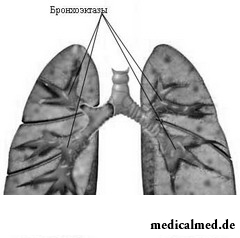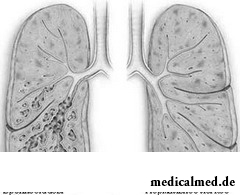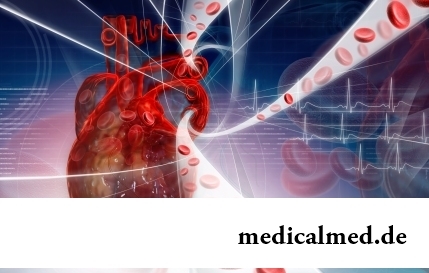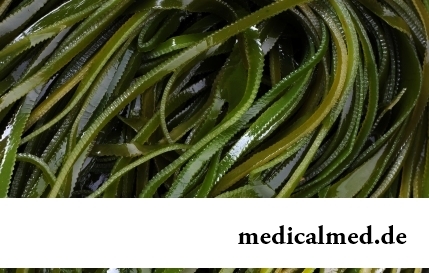





Bronchiectasia
Bronchiectasia – disease state which is defined by the localized irreversible expansion of a part of the so-called bronchial tree caused by destruction of muscles and elasticity of fabrics. The bronchiectasia is classified  as a chronic obstructive pulmonary disease, also as well as emphysema, bronchitis, asthma and cystous fibrosis. Bronchiectasias of lungs can result from various infectious diseases, including heavy and recurrent pneumonia, tuberculosis and a mucoviscidosis.
as a chronic obstructive pulmonary disease, also as well as emphysema, bronchitis, asthma and cystous fibrosis. Bronchiectasias of lungs can result from various infectious diseases, including heavy and recurrent pneumonia, tuberculosis and a mucoviscidosis.
Bronchiectasias of lungs happen inborn and acquired. They can be diagnosed by means of clinical analyses. It is recommended to carry out a computer tomography which can reveal anomalies of a bronchial tree and the available cysts for confirmation of the diagnosis. Also diagnosis of a disease usually includes blood tests and phlegms, and sometimes and tests for specific genetic disorders.
Also diagnosis a bronchiectasia includes the action following:
- Check of history of chronic respiratory symptoms (daily cough and phlegm);
- Analysis of a phlegm;
- Thorax X-ray analysis;
- Check of quantitative level of immunoglobulin for a hypogammaglobulinemia exception;
- Autoimmune screening tests.
For prevention the bronchiectasia at children's age needs to be imparted children from measles, whooping cough and other acute respiratory children's infections. The healthy index of body weight and regular visits of the doctor can exert beneficial influence on the prevention of progressing a bronchiectasia.
Reasons bronchiectasias
Bronchiectasias of inborn character are the reasons:
- Congenital infections which influence the movement of ions;
- Kartagener's syndrome;
- Cystous fibrosis;
- Jung's syndrome;
- Immunodeficiency;
- Williams-Campbell's syndrome;
- Marfan's syndrome.
Bronchiectasias of the acquired character are the reasons such diseases as:
- Tuberculosis;
- Pneumonia;
- Allergic bronchopulmonary aspergillosis;
- Bronchial tumors;
- Whooping cough;
- Staphylococcus;
- Pulmonary aspiration;
- AIDS;
- Ulcer colitis;
- Disease Krone;
- Hernia of an esophageal opening of a diaphragm;
- Pseudorheumatism.
Also bronchiectasias poisoning with toxic gases, the alcoholism, the use of drugs and various allergies influencing bronchial tubes can be the reasons.
and various allergies influencing bronchial tubes can be the reasons.
Symptoms bronchiectasias
Bronchiectasias carry to symptoms:
- Frequent green or yellow phlegm (to 240 ml a day);
- Pneumorrhagia;
- Unpleasant smell from a mouth;
- Frequent bronchial infections;
- Asthma;
- Rattles at a breath and an exhalation.
The aggravation caused by bacterial infections can lead bronchiectasias to the following symptoms:
- To the raised expectoration in comparison with an initial stage;
- The increased viscosity of a phlegm;
- Unpleasant smell of the allocated phlegm;
- Subfebrile temperature;
- Increase in the constitutional symptoms (fatigue, indisposition);
- Increase in an asthma, the complicated breath and lung pain.
Treatment bronchiectasias
Treatment bronchiectasias includes management of a bronkhoektaziyny infection, release from obstacles of respiratory tracts, removal of the affected parts of lungs by means of surgical intervention or embolization of arteries. Treatment includes long use of antibiotics for prevention of infections, and also elimination of the saved-up liquid using a postural drainage and physical therapy of a breast.
Operation can be also used for the localized treatment bronchiectasias and removals of obstacles which can cause a course of a disease.
Performing inhalation steroid therapy can reduce a phlegm and narrow respiratory tracts during a short span, and also help to prevent progressing of a bronchiectasia. This procedure is not recommended for treatment bronchiectasias at children.
In our intestines are born, millions of bacteria live and die. They can be seen only at strong increase, but if they gathered, then would be located in a usual coffee cup.

Producers of milk mixes for children assure: mixes are ideally balanced and adapted for needs of babies. In a sluch...
Section: Articles about health
Quite large number of people adheres to the principles of vegetarian food. But how to be if in a family of vegetarians there are children? Whether it is possible to eat also it the same as to parents, or after all the children's organism is not adapted for the use only раст...
Section: Articles about health
Scientists always aimed to offer fundamental explanations for medical problems. Their theories formed the basis of modern methods of treatment of the hardest pathologies and helped to save a set of lives. However stories are known also such theoretical constructions, following to which brought to mankind of a trouble and torture, ruined destinies and health of many people....
Section: Articles about health
It would seem, about it there can be no disagreements: water is necessary for a human body for normal zhiznedeyatet...
Section: Articles about health
The majority of gynecologic diseases prove three main signs, each of which speaks about need of a visit to the gynecologist. Certainly, it is possible to establish the exact diagnosis only after inspection, but on the basis of some signs it is possible пр...
Section: Articles about health
The problem of diagnosis was and remains to one of the most important in medicine. From that, the reason of an indisposition of the patient will be how precisely defined, eventually success of treatment depends. In spite of the fact that the majority of the diagnostic methods applied in official clinical practice has very high informational content and reliability, mistakes directed by diagnoses nevertheless are not excluded....
Section: Articles about health
Several decades ago the basil (the district khan, реан, Reagan) was considered as a part of the Caucasian or east cuisine, but today it is strong for...
Section: Articles about health
Eyes – unique body on the structure thanks to which the person obtains about 80% of information on the world around: about a form, color, size, the movement, and also many other parameters of objects or phenomena. But whether much we know about the most valuable body...
Section: Articles about health
Popular joke that there are no healthy people, and is nedoobsledovanny, most of us considers an honest truth, continually it is necessary to hear that all of us are sick hardly from a school bench. It is hard to say whether so it actually because too often people are treated for nonexistent diseases, and sometimes call a disease what is something another. Sometimes in it the doctors of old school making diagnoses which are cancelled long ago – medicine still unless are guilty...
Section: Articles about health
The state of health of the person in many respects depends on chemical composition of biological liquids of an organism. Specialists consider that з...
Section: Articles about health
The thought that the mass of their body is too big at least once in life visits from 80 to 95% of women. Many women are so obsessed with this idea that constantly try all new and new ways of weight reduction. Considerable part of these method...
Section: Articles about health
Partial and the more so full loss of hearing significantly reduces quality of life. Difficulties with communication lead to loneliness and isolation. The person who badly hears experiences difficulties with social and professional implementation, quite often has problems in private life....
Section: Articles about health
On the head of the person about one million hair follicles, or as they are called still, hair bulbs are located. At the moment he is born...
Section: Articles about health
It seems, quite recently you brought the baby from maternity hospital, but time flew by, and here it is already going to join the first in life children's collective. How to prepare the child for visit of a garden? What needs to teach him to facilitate process адап...
Section: Articles about health
The number of long-livers is very small. One person from 5 thousand lives up to age of 90 years, and the centenary boundary steps over only one of 20 thousand. However, doctors claim that each of us is quite able to affect own destiny. At the same time it is not so much about living as long as possible, how many about an opportunity to keep physical and intellectual activity and to avoid decrepitude. We will also talk about the ways helping to achieve this result today....
Section: Articles about health
Modern footwear is extremely various. It stopped being only protection for legs long ago. Today shoes, boots, barefoot persons in...
Section: Articles about health
The sclera and mucous membrane of an eye are intensively supplied with blood vessels which problem - to saturate nervous tissues of body with nutrients and oxygen. In a normality vessels are almost not noticeable, however at their expansion (owing to истонч...
Section: Articles about health
All diseases from nerves – in this joke a big element of truth, are said by doctors. Constant stresses lead to decrease in protective forces of an organism, and it becomes vulnerable for a set of diseases. It is wrong to think that the stress is a problem of the present. Life of people and hundred, and one thousand years ago also abounded with problems therefore need of a relaxation understood in ancient times – to some techniques more than one thousand years. The person needs knowledge of how it is possible to relax, this knowledge пригод...
Section: Articles about health
Household skills which to us so diligently imparted in the childhood it appears, not always bring only benefit. According to result...
Section: Articles about health
For residents of the countries of Southeast Asia various algas are an obligatory component of a daily diet. Their popularity is connected not only with high tastes, but also with numerous curative properties. Russians are a little familiar with...
Section: Articles about health
The state of health of the person depends on many factors. One of the most important is the constant, but not exhausting a physical activity. In the presence of various illnesses specialists often advise patients to do swimming which by right takes the leading place by efficiency of improvement, having at the same time a few contraindications. Today we will talk about the main directions of therapeutic impact of swimming on a human body....
Section: Articles about health
Phobia – the persuasive fear of a certain contents shown in a specific situation against the will of the person. Concepts of a phobia and fear...
Section: Articles about health
The pancreas performs two functions in a human body: release of enzymes without which digestion of carbohydrates, fats and proteins, and a producing hormones is impossible. The most important of them - insulin, is the main participant of carbohydrate metabolism, a normal...
Section: Articles about health
Small appetite at the child – the complaint which pediatricians should hear practically from each mother. Most often it is carried to the category of children's whims, however the refusal of food in certain cases can be to alarming symptoms therefore it cannot be ignored....
Section: Articles about health
Each failure in work of bodies and systems of a human body is, as a rule, shown by the whole complex of symptoms. In particular, N...
Section: Articles about health
Coffee – favourite drink of many. For the last decades it more than once already declared very harmful, extremely useful and even necessary for normal life activity. In spite of the fact that this product became for us usual for a long time, exists much...
Section: Articles about health
Doctors claim that the people not so familiar with a dorsodynia occur among adult Russians very seldom. At the same time the vast majority of the patients who are periodically testing this indisposition do not hurry to ask for medical care at all. On the one hand, there is an opinion that feelings of this sort at mature age are nearly natural phenomenon which is not doing serious harm to health. With another – practice of self-treatment various obezbol is eurysynusic...
Section: Articles about health
